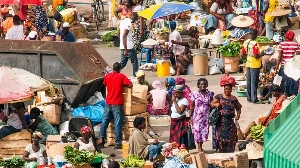 File photo of Makola Market [Image Credit: JAFEPX]
File photo of Makola Market [Image Credit: JAFEPX]
Data from the 2021 Population and Housing Census revealed that a total of 7.317,555 million people, representing 24.3 percent of the household population, were multidimensionally poor.
Among these poor people, 43.8 percent experienced severe poverty through deprivations in several dimensions simultaneously.
Out of the figure, 3,757,628 are females and 3,559,927 are males.
More than a third, representing 36.7 per cent of people living in rural areas, are multidimensionally poor.
The number of multi-dimensionally poor persons is highest in the Ashanti Region with 959,031, followed by the Northern region with 873,742, and lowest in the Ahafo Region with 135,644.
The Savannah region, representing 49.5 percent has the highest proportion of its household population who are multidimensionally poor, which is about two times higher than the national average of 24.3 percent.
Multidimensional poverty is a non-monetary measure of poverty that reflects the various areas in which the population may be deprived of their needs.
Omar Seidu, Director, Social Statistician, Ghana Statistical Service, announced this at the launch of a Ghana Multidimensional Poverty Report in Accra.
The report covered all 261 Metropolitan, Municipal, and Districts in the country.
The report showed that employment, which represents 32.6 percent and living conditions, which represents 27.9 percent contributed the most to multidimensional poverty.
Employment and health insurance, out of the 13 indicators of multidimensional poverty, contributed to more than 54.1 of the incidence of poverty in Ghana.
The district with the lowest proportion of its population who are multidimensionally poor is Asokwa Municipal in the Ashanti Region with 6.3 per cent.
The highest district is Nabdam with 68.6 percent in the Upper East Region.
The report revealed that multidimensional poverty in the country was generally highest among households with younger household heads below 25 years old or 60 years old.
The report showed that households headed by those working in the agricultural sector, representing 34.3 percent are poorer than those in the industry, with 8.9 percent and service, with 6.2 percent.
Also, the report revealed that the incidence of multidimensional poverty was highest among households whose heads were widowed, representing 32.0 percent.
Professor Samuel Kobina Annim, Government Statistician, said the report was relevant to Ghana’s commitment to achieving Sustainable Development Goal One “Ending Poverty in All its Forms Everywhere.”
He said the report identified specific areas where the poor were most deprived, allowing for a more precise allocation of resources and better monitoring of development programmes.
“The report does not only serve as a critical tool for understanding the multifaceted nature of poverty but also reinforces the need for integrated and comprehensive policy responses,” he said.